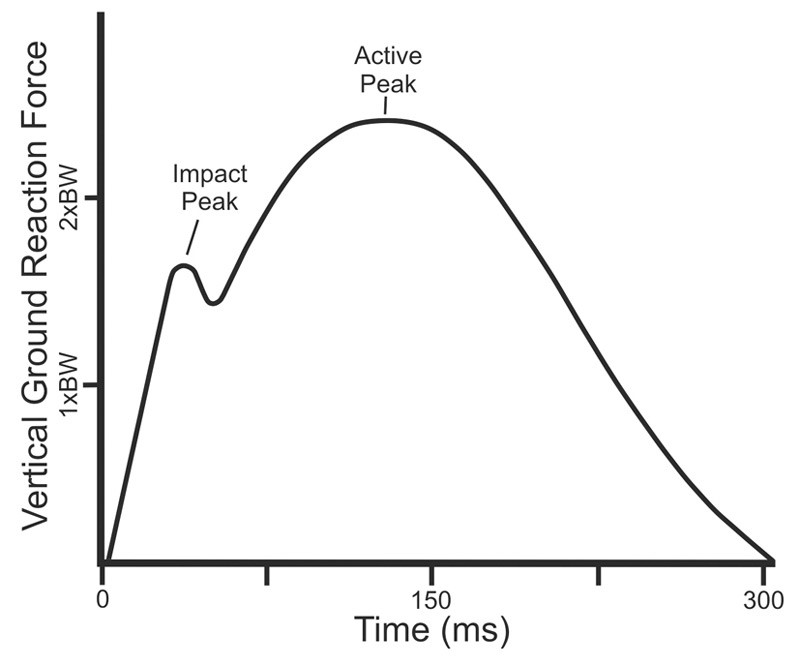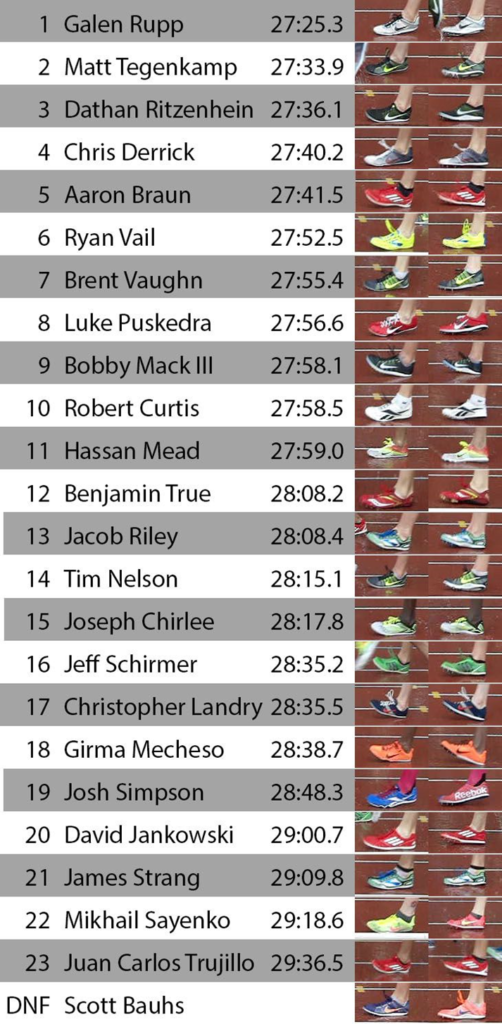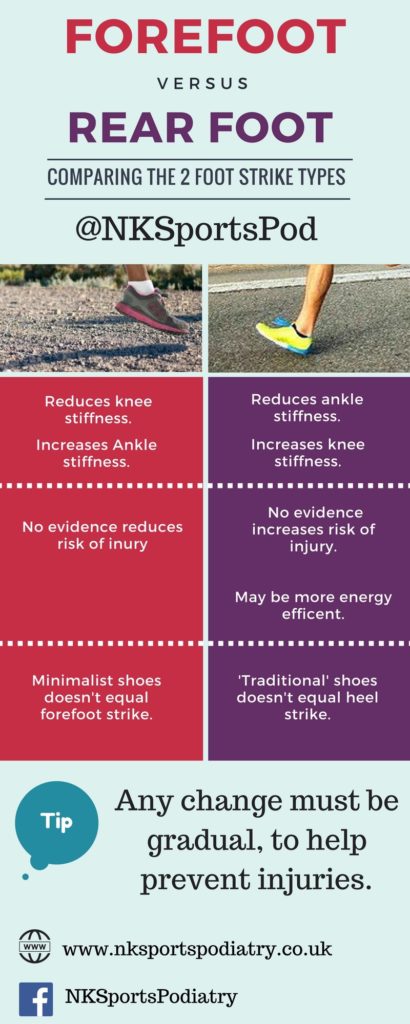I was asked on Twitter to speak about rear foot v forefoot strike pattern and what is best.
Like everything in life, there is no simple answer and no right or wrong answer. Unfortunately, whilst I was doing some research for this blog, I noticed there is still this notion that there is a correct way to run for everyone and that heel striking is the route of all evil and causes injuries. Well I am sorry but this is just not true, if it were that simple, life would get boring. Before we get into this, I understand there is the midfoot strike pattern, however I will just focus on the rear foot and forefoot strike pattern during this blog.
To try to keep things simple and not overcomplicate things, below is a graph of a force time curve, which shows this impact peak. In the past it was thought that this impact peak was a cause of running injuries, that it occurred just after heel strike and that running on your forefoot will eliminate this impact peak; hence the theory that forefoot running will reduce the risk of injury. Unfortunately, this does not seem to be the case as I’ve already stated there is no solid evidence out there currently that suggests that forefoot running reduces your risk of injury. To be honest we are not 100% sure if the impact peak has any relation to injury or not, the issue we have is the body’s central nervous system and again is different for everyone and whilst this impact peak is present everyone’s ability to tolerate this is different so in some people it may be related injuries and some people not. Hopefully future studies will help shed some light on this, although this research is difficult to undertake with large numbers of people.
[restrict userlevel=”subscriber”]

There were claims that people thought that forefoot running was more energy-efficient than a rear foot strike pattern, however some of the most recent studies do not agree with this.1-3 What we do know is that the lighter the shoe the less energy you use when running. Hence why ve racing flats and shoes in general are getting lighter and lighter.
We are all different, so the thought that one way of running is better than other, doesn’t sit right with me, or with the current evidence. What works for me, doesn’t mean it will work for you. Below is a picture from the Men’s 10,000m US trial event. Look at the difference between the left and right foot in these athletes. Now would you tell immediately level athletes that forefoot or rear foot striking is better, when they can run the 10,000 m quicker than most people?

A recent study looking at 434 recreational runners, found that 89.6% of runners landed with a rear foot strike pattern and 6.9% landed with midfoot and 3.5% with forefoot. As speed increased by 1 m/s the odds of having a forefoot strike pattern increased by 2.3 times. The study found that runners were 9.2 times more likely to run the forefoot strike pattern in minimalist shoes however 70% of the runners in minimalist shoes still continue to use rear foot strike pattern.4
Another recent study was also quite interesting and it looked at runners ability to detect their own foot strike pattern and 43.5% runners were unable to do this successfully. This is interesting because you then could delve into the psychological effects of thinking you are running one way when actually you are running in a different way, however this is a whole other blog.5
However, this doesn’t mean, a certain way of running can reduce the load through different parts of the body if there are some injuries, however the saying there is nothing free in life rings a bell, that load is just transferred to another region.
So let’s think about what we do and don’t know.
We know that the further forward you land on your foot the less load there is through the knee, however, that load is transferred down towards the ankle which becomes stiffer and the load through the Achilles tendons and calf muscle area increases, along with the load through the ball of the foot. So this may not be the best option if you are suffering with any Achilles, calf, planter fascia or metatarsal area injuries.
If you land further towards the heel we know that the load through the ankle and Achilles area reduces, however the load is then transferred towards the knee, so this may not be ideal for those experiencing patella femoral or Illio tibial band injuries.
This is not written in stone when looking at running technique as your foot strike pattern is one very small part in a very big picture; so it would be quite naive just to focus on foot strike alone.
We know that a difference in foot strike pattern can help alter the load going through the lower limb, is it possible to change this pattern as part of a gait re-education programme to help with any possible injuries you are suffering from? The short answer is yes, the big caveat though, it needs to be a gradual change, we know that the body has the ability to adapt to new loads and forces over time, with time been the big influence. The majority of injuries I see in clinic on a regular basis are people who have transitioned from a forefoot to a rear foot to a rear foot to forefoot strike pattern very quickly, your muscles, ligaments, tendons and bones have not had time to adapt to this new load, hence the possible reason for an injury.
Before you make any change in your foot strike pattern, you need to ask yourself ‘are you strong enough?’ For example, the forefoot loading pattern increases the workload through the calf muscle and Achilles; are yours strong enough to tolerate this without getting injured? Have you got the time to dedicate to making a gradual change, as it will take time? Ask yourself why do you want to change, if you are happy with your running and you are currently injury free, my advice is always if it’s not broke don’t fix it, as any change may introduce injury. Who knows? The evidence in 2 years’ time may be different!
To finish off, I often get asked in clinic, do I ever recommend a change in foot strike pattern. The answer is yes,. Quite often as part of a package of treatment including strength and conditioning, gait re-education, training advice, footwear advice etc. It is down to the individual presenting to me in clinic.
Below is an infographic to help try and summarise this blog. Please let me know a topic that you would like me to discuss for the next blog. Any questions, please do get in contact.

References
1) Gruber, A. H., Umberger, B. R., Braun, B., & Hamill, J. (2013). Economy and rate of carbohydrate oxidation during running with rearfoot and forefoot strike patterns. Journal of Applied Physiology. doi:10.1152/japplphysiol.01437.2012
2) OGUETA-ALDAY, A., RODRÍGUEZ-MARROYO, J. A., & GARCÍA-LÓPEZ, J. (2014). Rearfoot Striking Runners Are More Economical Than Midfoot Strikers. Medicine & Science in Sports & Exercise, 46(3), 580-585. doi:10.1249/mss.0000000000000139
3) Di Michele, R., & Merni, F. (2014). The concurrent effects of strike pattern and ground-contact time on running economy. Journal of Science and Medicine in Sport, 17(4), 414-418. doi:http://dx.doi.org/10.1016/j.jsams.2013.05.012
4) Larson, P., Higgins, E., Kaminski, J., Decker, T., Preble, J., Lyons, D., . . . Normile, A. (2011). Foot strike patterns of recreational and sub-elite runners in a long-distance road race. J Sports Sci, 29(15), 1665-1673. doi:10.1080/02640414.2011.610347
5) Bade, M. B., Aaron, K., & McPoil, T. G. (2016). ACCURACY OF SELF-REPORTED FOOT STRIKE PATTERN IN INTERCOLLEGIATE AND RECREATIONAL RUNNERS DURING SHOD RUNNING. International Journal of Sports Physical Therapy, 11(3), 350–355. [/restrict]




